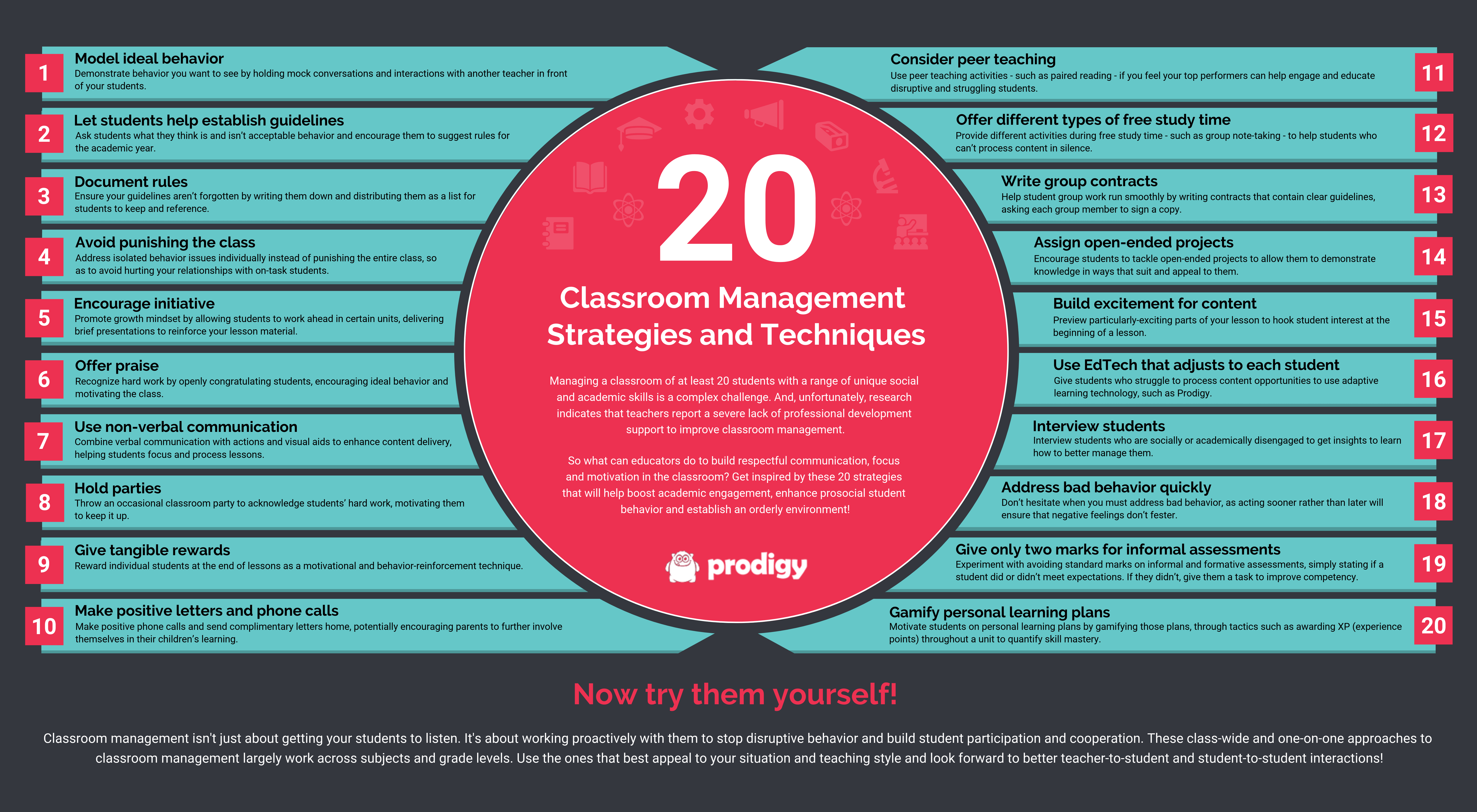Using Video Game Design To Motivate Students
Paper airplanes fly across the room. Students race between desks. You can't get a word in, as they yell over you.
Disruptive behavior doesn't have to be this dramatic, like a movie scene you'd watch in a media literacy lesson, but poor classroom management will almost assuredly elevate your stress and burnout rates.
Unfortunately, a 2019 report indicates that teachers overwhelmingly report a lack of professional development support in improving classroom management. Despite this unideal situation, there are straightforward and effective classroom management approaches you can implement by yourself. These approaches can enhance prosocial student behavior and academic engagement, establishing an orderly learning environment.
Available as a downloadable list to keep at your desk, below are 20 research-backed classroom management strategies and techniques.
Use the ones that best appeal to your situation and teaching style.
Universal classroom management strategies for educators
These 20 classroom management techniques have shown to improve classroom behavior, build relationships for a better classroom community, and foster a positive classroom environment where student learning is the number one collective goal.
Try these effective classroom management strategies with your students to become a happier, more effective teacher.
1. Model ideal behavior
Make a habit of demonstrating behavior you want to see, as many studies show that modelling effectively teaches students how to act in different situations.
A straightforward way to model certain behaviors is holding a mock conversation with an administrator, other teacher or student helper in front of the class. Talking about a test or other relatable topic, be sure to:
- Use polite language
- Maintain eye contact
- Keep phones in your pockets
- Let one another speak uninterrupted
- Raise concerns about one another's statements in a respectful manner
After, start a class discussion to list and expand upon the ideal behaviors you exemplified.
2. Let students help establish guidelines

Encourage all students to help you build classroom expectations and rules, as you'll generate more buy-in than just telling them what they're not allowed to do.
This is especially essential for new teachers. Near the start of the school year or during the first day of a semester, start a discussion by asking students what they believe should and shouldn't fly in terms of appropriate behavior.
At what points are phones okay and not okay? What are acceptable noise levels during lessons?
This may seem like you're setting yourself up for failure, but -- depending on the makeup of your class -- you may be shocked at the strictness of some proposed rules. Regardless, having a discussion should lead to mutually-understood and -respected expectations for your classroom culture.
3. Document rules
Don't let your mutually-respected guidelines go forgotten.
Similar to handing out a syllabus, print and distribute the list of rules that the class discussion generated. Then, go through the list with your students. Doing this emphasizes the fact that you respect their ideas and intend to adhere to them. And when a student breaks a rule, it'll be easy for you to point to this document.
You'll likely want to post these rules up in your classroom — if you haven't already — for occasional reference. If you're feeling creative, you can include the rule list in a student handbook with important dates, events and curriculum information, too.
4. Avoid punishing the class
Address isolated discipline problems individually instead of punishing an entire class, as the latter can hurt your relationships with students who are on-task and thereby jeopardize other classroom management efforts.
Instead, call out specific students in a friendly manner. For example:
- "Do you have a question?", not "Stop talking and disrupting other students"
- "Do you need help focusing?", not "Pay attention and stop fooling around while I'm talking"
This basic approach will allow you to keep a friendly disposition, while immediately acknowledging inappropriate behavior.
5. Encourage initiative

Promote growth mindset, and inject variety into your lessons, byallowing students to work ahead and deliver short presentations to share take-away points. Almost inevitably, you'll have some eager learners in your classroom. You can simply ask them if they'd like to get ahead from time-to-time.
For example, if you're reading a specific chapter in a textbook, propose that they read the following one too. When they deliver their subsequent presentations to preview the next chapter on your behalf, you may find that other students want a bit more work as well.
6. Offer praise
Praise students for jobs well done, as doing so improves academic and behavioral performance, according to a recent research review and study.
When it is sincere and references specific examples of effort or accomplishment, praise can:
- Inspire the class
- Improve a student's self-esteem
- Reinforce rules and values you want to see
Perhaps more importantly, it encourages students to repeat positive behavior. Let's say a student exemplifies advanced problem-solving skills when tackling a math word problem. Praising his or her use of specific tactics should go a long way in ensuring he or she continues to use these tactics. Not to mention, you'll motivate other students to do the same.
7. Use non-verbal communication

Complement words with actions and visual aids to improve content delivery, helping students focus and process lessons.
Many differentiated instruction strategies and techniques are rooted in these communication methods. For example, running learning stations -- divided sections of your classroom through which students rotate -- allows you to deliver a range of non-spoken content types. These include videos, infographics and physical objects such as counting coins.
8. Hold parties
Throw an occasional classroom party to acknowledge students' hard work, motivating them to keep it up.
Even if it's just for 20 or 30 minutes, they should be happy with snacks and a selection of group games to play. Clarify that you're holding the party to reward them and they can earn future parties by demonstrating ideal behavior, collectively scoring high on assessments and more.
9. Give tangible rewards

Reward specific students at the end of each lesson, in front of the class, as another motivational and behavior-reinforcement technique.
Let's say a few students are actively listening throughout the entire lesson, answering questions and asking their own. Before the class ends, walk over to their desks to give them raffle tickets. So others can learn, state aloud what each student did to earn the tickets. On Friday, they can submit their tickets for a shot at a prize that changes each week -- from candy to being able to choose a game for the next class party.
10. Make positive letters and phone calls
Keep students happy in and out of class by pleasantly surprising their parents, making positive phone calls and sending complimentary letters home.
When the occasion arises, from academic effort or behavioral progress, letting parents know has a trickle-down effect. They'll generally congratulate their kids; their kids will likely come to class eager to earn more positive feedback. This can also entice parents to grow more invested in a child's learning, opening the door to at-home lessons. Such lessons are a mainstay element of culturally-responsive teaching.
11. Build excitement for content and lesson plans

This one works well no matter the grade level: elementary school, middle school or high school. Start lessons by previewing particularly-exciting parts, hooking student interest from the get-go.
As the bell rings and students settle, go through an agenda of the day's highlights for the whole class. These could include group tasks, engaging bits of content and anything else to pique curiosity. For example, "Throughout the day, you'll learn about:"
- How to talk like you're a teacher (sentence structure)
- Why you don't know anyone who's won the lottery (probability)
- What all the presidents of the United States have had in common (social analysis)
The goal of this classroom management technique is to immediately interest students in your agenda and thereby dissuade misbehavior.
12. Offer different types of free study time
Provide a range of activities during free study time to appeal to students who struggle to process content in silence, individually.
You can do this by dividing your class into clearly-sectioned solo and team activities. In separate sections, consider:
- Providing audiobooks, which can play material relevant to your lessons
- Maintaining a designated quiet space for students to take notes and complete work
- Creating a station for challenging group games that teach or reinforce standards-aligned skills
- Allowing students to work in groups while taking notes and completing work, away from quiet zones
By running these sorts of activities, free study time will begin to benefit diverse learners. This should contribute to overall classroom engagement.
13. Write group contracts

Help student group work run smoothly and effectively by writing contracts that contain guidelines, having everyone sign.
Group contracts should be based on expectations that students have for each other, and you have for them. You can gather the class's thoughts by holding a discussion about what the ideal group member does, and how he or she acts. Once you've written the contract, encourage students to come up with consequences for violating expectations.
By having them sign a fresh version of the contract before each group task and project, you're empowering them to hold each other accountable.
14. Assign open-ended projects
Encourage students to tackle open-ended projects -- projects that don't demand a specific product -- to allow them to demonstrate knowledge in ways that inherently suit them.
This starts by giving the class a list of broad project ideas, asking each student to choose one. Be sure to provide a rubric for each project that clearly defines expectations. By both enticing and challenging students, you should notice they'll:
- Work and learn at their own paces
- Engage actively with appropriate content
- Demonstrate knowledge as effectively as possible
With these benefits, students may actually look forward to taking on new projects.
15. Give only two scores for informal assessments

Recall a time you saw a big "F" in red ink on your work. You were probably too upset to review mistakes and feedback, and so are your students when they see the same.
So, consider avoiding standard marks on informal and formative assessments.
Instead, just state if a student did or did not meet expectations. Then, provide struggling students with a clear path to improve. For example, pair classmates who didn't meet expectations with those who did, giving them a review and practice activity. When strugglers are confident they understand key concepts, encourage them to tell you. Provide a new assessment, allowing them to prove their competency.
Classroom management strategies for individual students
16. Use EdTech that adjusts to each student
Give students who struggle to process your content opportunities to try educational technology that adapts to their needs.
There are many games and platforms that use adaptive learning principles to detect a given student's skill deficits, serving them content to help overcome them. For example, Prodigy Math Game adjusts its content to help students address their trouble spots. It also offers feedback to help them solve specific mistakes, as they answer questions that use words, charts, pictures and numbers. More than one million teachers currently use Prodigy, as it's aligned with curricula across several English-speaking countries.
Sign up for your free teacher account today!
17. Interview students
Interview students who aren't academically engaged or displaying prosocial behavior to learn how to better manage them.
While running learning stations or a large-group activity, pull each student aside for a few minutes. Ask about:
- What helps them focus
- Who they work well with
- Their favorite types of lessons
- Their favorite in-class activities
- Which kinds of exercises help them remember key lesson points
Note their answers to come up with activities and approaches that engage them, thereby limiting classroom disruptions.
18. Address inappropriate or off-task behavior quickly

Avoid hesitation when you must address inappropriate or off-task behavior, especially when a student breaks a documented rule.
Acting sooner than later will help ensure that negative feelings -- whether between students or you and a student -- won't fester. Failure to act can result in more poor behavior, leading to needlessly-difficult conversations.
But keep in mind: It's usually best to talk to the student in private. Research shows that punishing students in front of peers has "limited value."
19. Consider peer teaching
Use peer teaching as a classroom management strategy if you feel your top performers can help engage and educate disruptive and struggling students.
Peer teaching activities, such as pairing students together as reading buddies, can beespecially beneficial for students who suffer from low confidence and poor interpersonal skills.
Authoritative research states tutors improve self-esteem and interpersonal skills by giving feedback. Tutees realize benefits because they can ask questions and receive immediate clarification. A later study of at-risk students echoes these advantages. Although you should spend time teaching peer tutors how to properly communicate with tutees, you'll likely find the benefits are worth the work.
20. Gamify personal learning plans

Motivate students on personal learning plans by gamifying those plans, as studies -- such as recent research from South Korea-- indicate this will continuously engage and incentivize them.
Consider gamification strategies such as:
- Adjusting your scoring system --Give experience points (XP) -- along with traditional scores -- on tests and assignments, setting a goal for the student to reach a certain amount of XP per unit. For example, if a student scores 60% on a quiz, give him or her 6,000 XP. You can also award XP for completing extra assignments, participating in class or anything else that shows effort to learn.
- Using stages --Refer to topics and units as stages. The former terms have clear connotations for you, but students may not see how they fit together. If they're gamers, they'll understand that reaching the next stage requires overcoming precursory challenges. Emphasize this by framing certain tasks as prerequisites to reach the next learning stage.
If these strategies work especially well for individual students, you should see similar success by using them as class-wide student management techniques.
Downloadable list of classroom management strategies for teachers
Click here to download a simplified list of the above classroom management strategies and techniques to print and keep at your desk.
Classroom management strategies infographic
Below is an infographic based on this article, helping you deploy these classroom management strategies at your own school!

Click to expand! Created by Venngage Infographics that recently launched its own banner maker.
Classroom management FAQs
What is the best classroom management style?
According to Diana Baumrind's work, a clinical psychologist known for her research on parenting styles, some educators believe an authoritative classroom management style may the best one. This type of high control, high involvement classroom management style is characterized by strong expectations of appropriate behavior, clear understandings of why certain behaviors are acceptable and others not acceptable, and warm student-teacher relationships.
However, there is no specific approach that has been proven to be the most effective. So you may wish to review The Classroom Management Book by Harry K. Wong and Rosemary T. Wong which includes a variety of solutions that can be easily implemented. Every group of students has varying needs and will likely need a unique approach to help every student bring his or her best self to the classroom and be ready-to-learn every single day.
What are the four components of classroom management?
Implementing the top four components of classroom management from the start will set you and your students up for success all year long. They are:
- Classroom design — be intentional about how you set up your desk, your students' desks, bulletin board displays, devices and other aspects of your classroom. Thoughtful classroom design can help create a safe and welcoming learning environment.
- Rules/discipline — to create a safe and caring school community, develop classroom rules your students understand and — hopefully — respect. While it may not be fun, be sure to communicate that breaking classroom rules will have concrete yet fair consequences.
- Scheduling/organization — being on time, keeping on task and staying organized will help set up your lessons (and your students' learning) up for success.
- Instructional technique — while you may not have the flexibility you'd like when it comes to content and curriculum, you should have the freedom to choosehow you teach. For example, 8th grade students may prefer a lecture-style lesson with small group discussions while 3rd grade students may prefer learning math with a digital game-based learning platform. Observe how your students learn best and use the classroom management strategies and techniques to teach your lessons.
Why is classroom management so important?
When done effectively, classroom management is important for three main reasons. It:
- Creates and sustains an orderly learning environment in the classroom
- Improves meaningful academic learning and fosters social-emotional growth
- Increases students' academic engagement and lowers negative classroom behavior
Final thoughts about these classroom management strategies
These class-wide and one-on-one approaches to classroom management largely work across subjects and grade levels. Implementable without admin and parent support, they should empower you to establish an orderly -- yet friendly and engaging -- environment.
Look forward to better teacher-to-student and student-to-student interactions as a result. Create or log in to your free teacher account on Prodigy. Aligned with curricula across the English-speaking world, it's loved by more than a million teachers and 100 million students.
Using Video Game Design To Motivate Students
Source: https://www.prodigygame.com/main-en/blog/classroom-management-strategies/
Posted by: gonzalezdoemon.blogspot.com

0 Response to "Using Video Game Design To Motivate Students"
Post a Comment